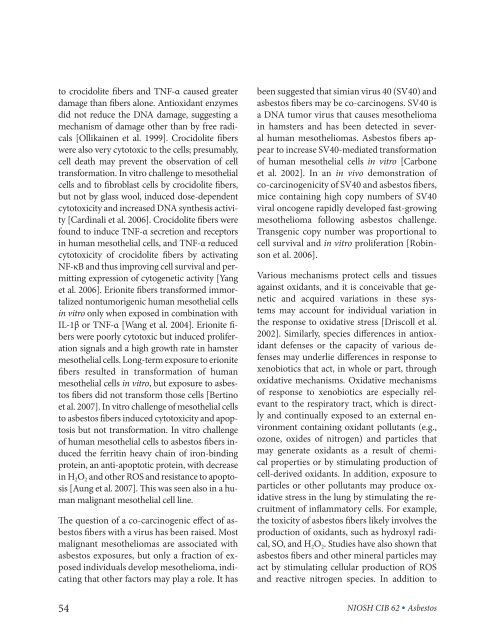Asbestos Fibers and Other Elongate Mineral Particles: State of the ...
Asbestos Fibers and Other Elongate Mineral Particles: State of the ...
Asbestos Fibers and Other Elongate Mineral Particles: State of the ...
- No tags were found...
You also want an ePaper? Increase the reach of your titles
YUMPU automatically turns print PDFs into web optimized ePapers that Google loves.
to crocidolite fibers <strong>and</strong> TNF-α caused greater<br />
damage than fibers alone. Antioxidant enzymes<br />
did not reduce <strong>the</strong> DNA damage, suggesting a<br />
mechanism <strong>of</strong> damage o<strong>the</strong>r than by free radicals<br />
[Ollikainen et al. 1999]. Crocidolite fibers<br />
were also very cytotoxic to <strong>the</strong> cells; presumably,<br />
cell death may prevent <strong>the</strong> observation <strong>of</strong> cell<br />
transformation. In vitro challenge to meso<strong>the</strong>lial<br />
cells <strong>and</strong> to fibroblast cells by crocidolite fibers,<br />
but not by glass wool, induced dose-dependent<br />
cytotoxicity <strong>and</strong> increased DNA syn<strong>the</strong>sis activity<br />
[Cardinali et al. 2006]. Crocidolite fibers were<br />
found to induce TNF-α secretion <strong>and</strong> receptors<br />
in human meso<strong>the</strong>lial cells, <strong>and</strong> TNF-α reduced<br />
cytotoxicity <strong>of</strong> crocidolite fibers by activating<br />
NF-κB <strong>and</strong> thus improving cell survival <strong>and</strong> permitting<br />
expression <strong>of</strong> cytogenetic activity [Yang<br />
et al. 2006]. Erionite fibers transformed immortalized<br />
nontumorigenic human meso<strong>the</strong>lial cells<br />
in vitro only when exposed in combination with<br />
IL-1β or TNF-α [Wang et al. 2004]. Erionite fibers<br />
were poorly cytotoxic but induced proliferation<br />
signals <strong>and</strong> a high growth rate in hamster<br />
meso<strong>the</strong>lial cells. Long-term exposure to erionite<br />
fibers resulted in transformation <strong>of</strong> human<br />
meso<strong>the</strong>lial cells in vitro, but exposure to asbestos<br />
fibers did not transform those cells [Bertino<br />
et al. 2007]. In vitro challenge <strong>of</strong> meso<strong>the</strong>lial cells<br />
to asbestos fibers induced cytotoxicity <strong>and</strong> apoptosis<br />
but not transformation. In vitro challenge<br />
<strong>of</strong> human meso<strong>the</strong>lial cells to asbestos fibers induced<br />
<strong>the</strong> ferritin heavy chain <strong>of</strong> iron-binding<br />
protein, an anti-apoptotic protein, with decrease<br />
in H 2O 2 <strong>and</strong> o<strong>the</strong>r ROS <strong>and</strong> resistance to apoptosis<br />
[Aung et al. 2007]. This was seen also in a human<br />
malignant meso<strong>the</strong>lial cell line.<br />
The question <strong>of</strong> a co-carcinogenic effect <strong>of</strong> asbestos<br />
fibers with a virus has been raised. Most<br />
malignant meso<strong>the</strong>liomas are associated with<br />
asbestos exposures, but only a fraction <strong>of</strong> exposed<br />
individuals develop meso<strong>the</strong>lioma, indicating<br />
that o<strong>the</strong>r factors may play a role. It has<br />
54<br />
been suggested that simian virus 40 (SV40) <strong>and</strong><br />
asbestos fibers may be co-carcinogens. SV40 is<br />
a DNA tumor virus that causes meso<strong>the</strong>lioma<br />
in hamsters <strong>and</strong> has been detected in several<br />
human meso<strong>the</strong>liomas. <strong>Asbestos</strong> fibers appear<br />
to increase SV40-mediated transformation<br />
<strong>of</strong> human meso<strong>the</strong>lial cells in vitro [Carbone<br />
et al. 2002]. In an in vivo demonstration <strong>of</strong><br />
co-carcinogenicity <strong>of</strong> SV40 <strong>and</strong> asbestos fibers,<br />
mice containing high copy numbers <strong>of</strong> SV40<br />
viral oncogene rapidly developed fast-growing<br />
meso<strong>the</strong>lioma following asbestos challenge.<br />
Transgenic copy number was proportional to<br />
cell survival <strong>and</strong> in vitro proliferation [Robinson<br />
et al. 2006].<br />
Various mechanisms protect cells <strong>and</strong> tissues<br />
against oxidants, <strong>and</strong> it is conceivable that genetic<br />
<strong>and</strong> acquired variations in <strong>the</strong>se systems<br />
may account for individual variation in<br />
<strong>the</strong> response to oxidative stress [Driscoll et al.<br />
2002]. Similarly, species differences in antioxidant<br />
defenses or <strong>the</strong> capacity <strong>of</strong> various defenses<br />
may underlie differences in response to<br />
xenobiotics that act, in whole or part, through<br />
oxidative mechanisms. Oxidative mechanisms<br />
<strong>of</strong> response to xenobiotics are especially relevant<br />
to <strong>the</strong> respiratory tract, which is directly<br />
<strong>and</strong> continually exposed to an external environment<br />
containing oxidant pollutants (e.g.,<br />
ozone, oxides <strong>of</strong> nitrogen) <strong>and</strong> particles that<br />
may generate oxidants as a result <strong>of</strong> chemical<br />
properties or by stimulating production <strong>of</strong><br />
cell-derived oxidants. In addition, exposure to<br />
particles or o<strong>the</strong>r pollutants may produce oxidative<br />
stress in <strong>the</strong> lung by stimulating <strong>the</strong> recruitment<br />
<strong>of</strong> inflammatory cells. For example,<br />
<strong>the</strong> toxicity <strong>of</strong> asbestos fibers likely involves <strong>the</strong><br />
production <strong>of</strong> oxidants, such as hydroxyl radical,<br />
SO, <strong>and</strong> H 2O 2. Studies have also shown that<br />
asbestos fibers <strong>and</strong> o<strong>the</strong>r mineral particles may<br />
act by stimulating cellular production <strong>of</strong> ROS<br />
<strong>and</strong> reactive nitrogen species. In addition to<br />
NIOSH CIB 62 • <strong>Asbestos</strong>

















